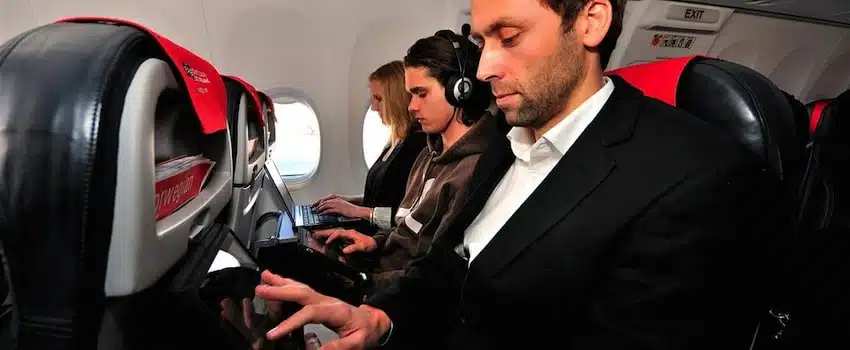No in-flight Wi-Fi? Who made THAT decision?
Henry Blodget, writing in Business Insider, says he was aghast, while flying JetBlue, that he could not connect to Wi-Fi at 35,000 feet. While the airline has promised to bring “free and plenty” of Wi-Fi soon, they are late to the game, and passengers are taking notice.
My laptop wasn’t broken. The plane’s WiFi wasn’t broken. There wasn’t something special about how you connected to JetBlue’s WiFi.
The reality was… JetBlue doesn’t have WiFi.
Seriously!
What is that about?
Who made THAT decision?
What does JetBlue expect you to do for five hours while you float across the country if you don’t have WiFi?
Watch television?
Eat blue potato chips?
In 2011, over 200 million people in the US boarded a plane with in-flight Wi-Fi, according to Gogo. This year, the number is likely to exceed 500 million, with Delta, Virgin America, American offering Wi-Fi across their domestic fleet. Internationally, all of Emirates’ A380s and many long haul flights on Singapore Airlines and Lufthansa offer Wi-Fi. By the end of the year, even smaller airlines like Cebu Pacific and Philippine Airlines will offer in-flight connectivity.
So, if your airline has not made the decision to get in-flight Wi-Fi yet, it won’t be long before someone asks, “Who made THAT decision?”. You will be conspicuous by the absence of wi-fi!
Read the rest of the article here.
Air China offers in-flight Wi-Fi, but says no to smartphone usage
Another example of an airline that probably launched Wi-Fi before thinking things through. How can an airline launch in-flight connectivity and not allow smartphones to use it, which almost seems to have these days. In fact, on Emirates and Singapore Airlines, smartphone usage far exceeds laptop usage for in-flight connectivity. Air China probably needs to revise this policy soon, or someone else might say to them, “Who made THAT decision?”
Read the rest of the article here.
Meanwhile, our good friends over at the Apex Editor’s Blog have more detailed technical information about Air China’s in-flight product.
Delta CEO’s compassion touches hearts
It’s not often that senior airline executives are in the news for being human. But Delta Air Lines’ CEO did just that when he gave up his seat and flew in the jump seat, just to allow a paying passenger to get a seat on an overbooked flight. The passenger was touched because she was just a “normal” person, and yet was made to feel special. That made the news.
Ultimately, a kind act from a senior executive does more for an airline’s brand, than all airline marketing efforts put together.
Read more here.
Your brand is not what you say it is, it’s what they say it is
Malaysia Airlines, like many other legacy airlines, has recently released a refreshed set of TV and print advertisements. While classy and of high quality, the Brand Consultant Asia blog couldn’t help but wonder about the relevance of such sweeping, untargeted marketing campaigns in today’s world.
And rightly so — ours is a world of the Connected Traveller. They need to be micro-targeted, and will not be impressed by generic TV campaigns. We’re hoping Malaysia Airlines follows up on these new ads with complementary digital engagement too, which target specific segments of the market through media they use.
I’ve been flying MAS for over 20 years and I think it has a great product but it needs to work on its brand. A lot of work. This traditional approach to brand building is not going to help steer the airline to full year profitability. They’d be better off throwing the money down a black hole.
I feel MAS is wasting money using tactics that were relevant 30 years ago but not today – the ‘one-size-fits-all’ mass market approach that tries to talk to everyone at the same time in the hope that some of it will stick.
Read the complete Brand Consultant Asia blog-post here.
Iberia’s Unique Mobile App Strategy
Our good friends over at Skift have a good account of Iberia’s latest splash in the mobile app arena: five single-function mobile apps instead of a single, consolidated one. Yes, you read that correctly. While mobile is undoubtedly an important aspect of modern marketing considerations, it is indeed a strange move from Iberia — at the surface it seems to be contrarian for the sake of it without any real utility for smartphone users who already find themselves drowning under a deluge of app launches by everyone around them. And five just from one airline might just cause more irritation than admiration.
For more insights, as well as Iberia’s justification for the move, read the complete article here.
Tiger Airways rebrands, looks to be more warm and genuine
And finally, from the SimpliFlying stable, here’s an evaluation of Tiger Airways’ latest move to rebrand itself to Tigerair.
If Tigerair wants to be genuine, then they need to figure out the key brand touchpoints and ensure genuine service is delivered across all of them. If they want to be warm, then the cabin crew and ground staff needs to be re-trained to deliver a warm service. And passion is something that can hardly be inculcated through training – it comes naturally. So they probably need to hire a different set of people, if they are to deliver their brand promises, which the new image aims to bring forth.
Read the complete article here.
